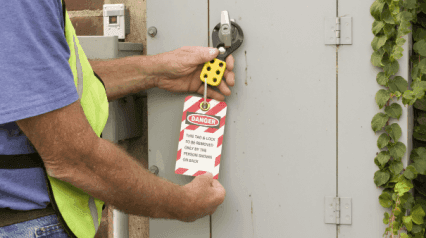What is a Lockout/Tagout (LOTO) Procedure?
A lockout/tagout procedure is a safety protocol used in various industries to ensure the safety of workers during the maintenance or repair of machinery or equipment. It involves locking and tagging the energy sources of the equipment to prevent accidental startup or release of hazardous energy. This procedure helps to protect workers from potential injuries or fatalities caused by unexpected energization or release of stored energy.
Benefits of Lockout/Tagout Procedures
Here are some key benefits of implementing lockout/tagout procedures:
- Prevents Accidents and Injuries – LOTO procedures isolate energy sources and ensure proper equipment shutdown before maintenance or servicing work. It helps to prevent accidental startups, releases of stored energy, and other potential hazards, thereby reducing the risk of employee accidents and injuries.
- Protects Workers’ Lives – They effectively control hazardous substances, preventing fatalities and injuries such as electric shocks, amputations, burns, and other life-threatening incidents.
- Ensures Compliance with Regulations – Adhering to regulations, such as the Occupational Safety and Health Administration (OSHA) standards, enables businesses to prevent penalties and legal repercussions while prioritizing the safety and well-being of their employees.
- Improves Efficiency and Productivity – LOTO procedures provide clear guidelines and standardized processes, which streamline maintenance operations, reduce downtime, and minimize equipment damage or malfunctions.
- Enhances Communication and Awareness – It helps create a safety culture, informing everyone about potential hazards and safety measures related to specific equipment or machinery.
- Encourages Risk Assessment and Continuous Improvement – This procedure helps proactively identify areas for improvement in equipment design, maintenance practices, and employee training. By regularly reviewing and enhancing lockout/tagout procedures, businesses can address safety concerns proactively and prevent future incidents.
Who is Responsible for the Lockout Program?
Every party involved in the workplace has a responsibility in the lockout program. Below are some of the critical roles and responsibilities:
Management
- Develop, review, and update lockout policies and procedures
- Identify the employees, machines, equipment, and processes involved
- Supply the required Personal Protective Equipment (PPE), hardware, and appliances
- Monitoring and measuring the program’s compliance
Supervisors
- Provide employees with PPE, hardware, and appliances, and ensure proper use
- Develop equipment-specific procedures for machines, equipment, and processes
- Ensure that only properly trained employees perform lockout-related services or maintenance
- Observe that employees under their supervision adhere to lockout procedures
Authorized Individuals
- Follow the established procedures
- Report any problems with the methods, equipment, or tagging out process
What Information Should Be Included in Lockout Procedures and Work Instructions?
An organization typically has one lockout program for overall safety. Still, a detailed procedure or work instruction should outline the steps to control hazardous energy for each specific machine or equipment. The written lockout procedure should include the following specifications:
- The particular machine, equipment, or process required for the shutdown and isolation process
- The hazardous energy present and the energy-isolating or de-energizing device required to control it.
- The locations where lockout devices are necessary and the proper installation procedures
- The steps for safely managing stored or residual energy include shutting down, isolating, blocking, securing, and relieving it
- The process for placing and removing lockout devices
- Various methods for verifying isolation
- Methods of communication about the lockout and the restoration of services
Procedures and work instructions may include visual aids and descriptions of the steps involved for better understanding.
Improve your EHS Management
Cultivate a safe working environment and streamline compliance with our EHS solutions.
Explore now10 Steps to Perform LOTO Procedures
The lockout/tagout procedure should include the following essential steps.
Step 1: Determine the Appropriate Procedure
Find the appropriate lockout/tagout procedure for the machine or equipment, and check if it’s stored in a binder or a database where it can be accessed by workers. The process should include specific equipment details and offer step-by-step instructions for safely shutting down and restarting the equipment.
Step 2: Get Ready for the Shutdown
Before commencing any work, conducting a comprehensive review of all procedure components is crucial. It includes identifying the required personnel and equipment for the shutdown and adequately training all participating employees. The training should encompass various aspects of the shutdown, including the following.
- Energy-related hazards associated with equipment
- Methods or means of controlling energy
- Amount and type of energy
Step 3: Inform All Concerned Employees
All employees who may be affected should be informed about the upcoming maintenance. It should include the date and time of the work, the equipment that will be affected, and the estimated duration of the maintenance.
Ensure they’re aware of alternative processes to use during the maintenance. Additionally, provide the name of the person responsible for the lockout/tagout procedure and the contact information for further inquiries.
Step 4: Shut Down the Equipment
Following the directions in the LOTO procedure is essential because many machines and equipment have complex shutdown processes. Ensure that all moving parts, such as flywheels, gears, and spindles, have stopped moving. Verify that all controls are in the off position.
Step 5: Isolate the Equipment
When shutting down equipment or machines, isolating them from all energy sources is essential. You can do this by shutting down all power sources on the machine or equipment and turning off the circuit breakers. Shutting off energy sources includes:
- Chemical
- Electrical
- Hydraulic
- Mechanical
- Pneumatic
- Thermal
The details of this step will vary for each machine or equipment type, but the LOTO procedure should include information about the energy sources to address. It’s important to neutralize every energy source at the appropriate sources and block movable parts to prevent errors.
Step 6: Add the Individual Locks

Lockout Device
Attach the designated lockout/tagout devices to the power sources for each team member involved. Secure the power sources with locks and attach tags as necessary.
- Machine controls
- Pressure lines
- Starter switches
- Suspended parts
Each tag should include specific information, such as the date and time of tagging, the reason for the lockout, and personal information related to the tagger.
Step 7: Check Stored Energy
Check the following areas for stored or residual energy on the machine or equipment.
- Capacitors
- Elevated machine members
- Hydraulic systems
- Rotating flywheels
- Springs
Additionally, it’s essential to check for stored energy such as air, gas, steam, or water pressure.
Step 8: Make Sure the Machine or Equipment Is Isolated
Disconnect all energy sources from the system. Look for any missed sources by visually inspecting the area. Test the equipment to confirm the shutdown, such as pressing buttons, flipping switches, testing gauges, or operating controls. However, ensure that the area is clear of other personnel to avoid interacting with hazards.
Step 9: Shut off the Controls
After completing the test, return the controls to the off or neutral position. It’ll complete the lockout/tagout procedure for the equipment or machine, allowing you to begin working on the maintenance.
Step 10: Restore the Equipment to Working Order
Clear the area of unnecessary items and arrange all operational components properly. All employees must be in safe positions or outside the designated area.
Check that the controls are in a neutral position. Remove the lock and tag devices and turn on the equipment or machine again. As specified in the LOTO procedure, turning on some machines and equipment may be necessary before removing lock devices. After finishing, inform all affected employees that maintenance is complete and the machine or equipment is ready to be used.




